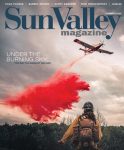Wild west outlaws, Robert Parker and Henry Longabaugh, have become permanent fixtures of the American zeitgeist due to the epic teaming of Paul Newman and Robert Redford in the highest grossing film of 1969: Butch Cassidy and the Sundance Kid—an exuberant, comedic, and not exactly historically accurate take on the real-life adventures of these western icons who had the longest run of “successful” bank and train robberies in the known history of the Old West. Here is John Lundin, local author and historian, on the duo and their time spent in Idaho robbing trains that were on railroads built by Sun Valley founder, EH Harriman.
Butch Cassidy (Robert Leroy Parker), Sundance Kid (Henry Longabaugh) and their gang (the Hole in the Wall and/or Wild Bunch) were the most prolific, successful and best-known robbers in the American West.
Butch was a master planner and escape artist who organized a string of holdups and was sometimes known as the “American Robin Hood.”
They were memorialized by the 1969 movie, Butch Cassidy and the Sundance Kid, starring Paul Newman as Butch, Robert Redford as Sundance, and Katherine Ross as Etta Place (Butch’s girlfriend).
Idaho State University Professor Phillip Homan has uncovered new information about the gang. Based on Pinkerton National Detective Agency records at the Library of Congress, Homan is writing a biography of Kittie Wilkins, the Horse Queen of Idaho.
Butch’s involvement in Idaho started with the robbery of the Bank of Montpelier on August 13, 1896. The sheriff chased the gang on a bicycle, who escaped when they got on fresh horses hidden for their getaway, scenes shown in the movie.
In 1897, New York financier Edward H. Harriman bought Union Pacific out of bankruptcy, transforming it “from a faded, mediocre carrier to the most efficient railroad west of the Mississippi River,” historian Maury Klein stated. This enabled his son, Averell, to establish Sun Valley in 1936.
Butch’s gang became famous for robbing U.P. trains in June 1899, and in August 1900, between Rawlins and Green River, Wyoming, as they crossed the Continental Divide; a high plateau that was a bleak tundra of uninhabited land into which robbers could escape. The robberies led Harriman to hire Pinkerton detectives to capture the gang. Harriman created “mobile posses,” where men and horses waited in boxcars to chase bandits. In the movie, Butch lamented it would have been cheaper for Harriman to pay him not to rob his trains, than to hire the Pinkerton Agency to stop him.
Cassidy became concerned that the outlaw profession was in trouble. Much of the west had become settled. Rapid communications used by lawmen made escaping more difficult, including telegraph lines connecting most towns, the arrival of the telephone, and trains that crossed the country in days. Butch decided to leave for South America, financed by robbing a bank in Winnemucca, Nevada.
In September 1900, on the way from Wyoming to Nevada, Will Carver, Butch Cassidy and likely other gang members stayed at the McFall House in Shoshone, Idaho. Two gang members hid part of their loot nearby. The McFall House was built by the author’s great-grandfather Matt McFall in 1900, and his family lived there.
On the way to Winnemucca, Butch stole one of Kittie Wilkins’s horses, a white Arabian, from the Wilkins Horse Company in the Bruneau Valley, Idaho. When they camped at the CS ranch near Winnemucca, the young son of the ranch’s foreman lost a horse race with Cassidy, who was riding the Arabian. Butch told the boy, “You like the horse? Someday he will be yours.”
The gang robbed the First National Bank in Winnemucca on September 19, 1900, netting $32,640. A posse chased Butch and Sundance back to Idaho. When they changed to fresh horses, Butch yelled to the posse, “give this white horse to the kid at the CS Ranch.” The posse took the horse to the boy, who later said, “for Butch to remember his promise to a kid when the posse was so close, he could not have been all bad.”
The gang reunited in Fort Worth, Texas, at Madame Fannie Porter’s brothel, where two married prostitutes—Will Carver married Lillie Davis and Harvey Logan married Annie (Maud) Rogers. The gang had their picture taken wearing their finest dress. The photo was widely circulated, giving them an image of glamour and sophistication, but detectives used the picture to identify and hunt them down.
In December 1900, Carver and Logan took their wives by train to Shoshone for their “honeymoon.” According to Carver’s wife’s confession to a Pinkerton detective, they stayed at the McFall House. Carver and Logan likely registered using their aliases, William Casey and Bob Nevilles.
Carver and Logan left for five days, returning with loot they had retrieved, including several bags of gold. They were liberal spenders, buying lavish dinners, champagne, fine buggies and horses, and “many fine hats with droopy ostrich feathers for Lillie.” They traveled to Helena, Butte, Denver and San Antonio, where Lillie received more presents and money, according to Logan’s deposition for Annie Rogers at Nashville.
Butch, Sundance and Etta left for South America in 1901. Some accounts say Butch and Sundance did not die there and returned to the U.S. Their lives have become legendary, and they are icons of the Old West.
Butch and Sundance’s exploits seem like ancient history. However, when they stayed at the McFall House in 1900, the author’s grandmother was 10 years old and living there with her family. She likely saw the men in the lobby, interacted with them, or even talked to them. Thus, our family provides a direct link between Butch and Sundance’s Old West and the present day.


